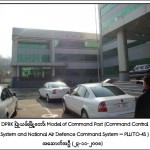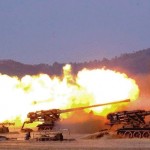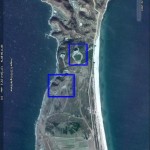As the xenophobic North Korean regime of Kim Jong Il appears to be inching toward a murky transition of power, the United Nations is laying plans to spend more than $290 million on a welter of programs in the communist state—including a scheme to produce an algae sold in the U.S. as tropical fish food–provided someone else comes up with much of the money.
The money is by no means a sure thing, especially if the unpredictable North Korean dictator rejects any of the stringent oversight conditions attached to money from some of the important donors the U.N. hopes will chip in.
The U.N. plans, however, demonstrate the determination of the world organization and its most influential backers—notably, the U.S. government, which is the biggest single financial supporter of most U.N. aid and development organizations– to keep dangling carrots of assistance before the North Korean regime, even at its most provocative.
The U.N. plans persist despite such incidents as the March 26 sinking of a South Korean warship, the Cheonan, most likely by a North Korean submarine, and the regime’s continued nuclear saber-rattling, especially toward South Korea. Just last month, for example, North Korea threatened a “powerful nuclear deterrence” in response to a joint U.S.-South Korean antisubmarine exercise prompted by the Cheonan incident.
All those uncertainties fade, however, alongside a bigger one: rumors that the ailing and reclusive Kim, who returned on Sunday from his second trip to China in three months, hopes to install his youngest son, Kim Jong-Un, as his successor– a process that could already be well under way.
Whatever the outcome of the succession process, at least a dozen U.N. agencies and offices clearly hope to be deeply involved over the next five years in North Korea’s national welfare, in areas ranging from health care and education to sanitation and civil service training, “strengthening knowledge networks” in agriculture, alternate energy development, and transportation, not to mention improving North Korean export trade.
A significant number of the efforts will also go to bolstering the capabilities of the North Korean government, which is not surprising, since they are prepared in close collaboration with various departments of the ruling apparatus. These efforts include a strong focus on health care delivery and education (already problematic in a totalitarian state burdened with a smothering cult of the personality).
But they also include more ambiguous activities in a brutal and thorough-going dictatorship such as North Korea. Among them: coordinating “national knowledge networks and practices,” “management and specialist training,” and—in a country that regularly threatens its neighbors with nuclear and conventional war—a “disaster preparedness and response strategy” spurred by North Korea’s famines and floods. All of these activities are depicted by the U.N. documents as being strictly humanitarian in nature.
The array of plans is laid out in schematic form in a 22-page “United Nations Strategic Framework Results Matrix” for North Korea, which is being presented to members of the supervisory Executive Board of the United Nations Development Program (UNDP), the U.N.’s principal development coordinating agency, at a meeting in New York this week.
Click here for the matrix.
The framework is buttressed by UNDP’s own country program for North Korea, which is a $38.3 million portion of the larger total. Both documents cover the period from 2011 to 2015.
Click here for the UNDP Country Program.
The UNDP contribution is noteworthy, among other things, for the fact that most of the money–$34 million—can be counted on to exist. That amount is described in the annex to the country program as coming from “regular” UNDP resources, meaning its core budget. Only $4 million of UNDP’s spending in North Korea comes from other contributions.
A UNDP spokesman underlined—as does the country program—the extent to which UNDP claims to be adhering to newly strengthened safeguards in relation to its North Korean program.
UNDP activities in North Korea exploded into scandal in 2007, leading to suspension of its program until 2009. Among other things, an independent investigative panel subsequently determined that UNDP had wrongfully provided millions in hard currency to the North Korean regime, ignored U.N. Security Council sanctions in passing on dual-use equipment that could conceivably be used in the country’s nuclear program, and allowed North Korean government employees to fill key positions.
In the current program, UNDP emphasizes that it has revamped its hiring and currency policies, but adds that “a proper monitoring and evaluation plan is necessary to ensure accountability and transparency in project implementation.” The careful wording indicates that at least some of that planning remains to be done.
While UNDP has actual cash to spend, however, nearly $119 million of some $128 million that UNICEF plans to spend in North Korea over the next four years—about 93 per cent—is expected to come from outside donors, according to UNICEF’s own country plan for North Korea. That is, as UNICEF delicately puts it, “subject to the availability of specific purpose contributions” from those willing to put up the money.
Click here for the UNICEF Country Program.
Much of that volunteer UNICEF money would go toward building up North Korea’s grievously neglected clinical health care facilities, bolstering maternal and early childhood care, early childhood education and large-scale vaccination and medication campaigns to fight AIDs, malaria and tuberculosis.
Most of the anti-disease money is supposed to come from the Global Fund to Fight AIDS, Tuberculosis and Malaria (GFATM), a Geneva-based institution financed in part of Microsoft Found Bill Gates and his wife, Melinda. Nowadays, the U.S. government contributes 28 percent of the GFATM’s funds.
And so far, GFATM has only handed over $12.45 million to UNICEF, according to the U.N. agency’s spokesman, Chris de Bono, for its anti-malarial and TV campaign. (According to GFATM’s website, UNICEF has received $18.35 million, out of about $31.5 million approved so far.) According to de Bono, another $56 million is due to come from GFATM starting in 2013, provided a “number of conditions” laid down by the Global Fund are met.
Those conditions, according to Global Fund communications director Jon Liden, largely bear on whether the money is meaning the health goals set by the donors. Among them, for example, is a commitment to cut in half the North Korean death rate from malaria by 2013, using the death rate in 2007 as a baseline (0.31 per 1,000 people, vs. 0.62.).
Click here for Global Fund report on North Korea.
Failure to meet the targets could result in reduced funding for the next three years, or a cutoff.
The additional “other” revenues required by UNICEF for 2011-2015 will be raised “as we get into our program,” according to spokesman De Bono, “as is our usual practice.”
The same apparently applies to the bulk of $101 million or so to be spent in North Korea by the World Health Organization (WHO). WHO activities include supporting UNICEF on the malaria and TB campaigns, but also building up North Korean health care, supplying equipment and drugs, and helping institute telemedicine.
But WHO’s own “country cooperation strategy” for North Korea extends only to 2013, meaning all of its fundraising plans for the 2011-2015 have not yet been written.
In the current strategy document, completed in 2009, WHO notes that it will need to use about $3 million of its regular budget and mobilize $20 million annually from voluntary contributions to meet North Koreas needs. This, the document says, “will be a challenging task.”
Just how challenging, perhaps, can be seen in the case of the struggling World Food Program (WFP), whose efforts are outlined in the U.N. Strategic Framework as trying to provide “fortified locally produced nutritious foods” to young children.
In fact, WFP has been running a dwindling operation to provide emergency food to many more of North Korea’s desperately hungry population. But donors stampeded away from the WFP fundraising effort, especially after the Kim regime detonated a nuclear device last year, and questions were raised about whether the government was profiting from the food effort.
Questioned Raised About Who Profits From Aid to North Korea
Currently, WFP has dialed back the goal of its emergency food aid operation from $500 million in 2008-2009 to $91 million.
In the 2011-2015 strategic framework, UNDP and the Rome-based Food and Agriculture Organization will be working on amplifying North Korea’s meager food supply, enhancing, among other things, areas where “double-cropping” is possible, and adding to fruit orchards and livestock herds. UNDP’s project documents say it will spend $13 million on “seed production in alternative cereals” –defined as wheat, barley, soybeans, potatoes—as well as “wild fruit processing and protein-rich production.”
Some of UNDP’s protein projects, however, seem decidedly outside the mainstream, or even bizarre. In its program document, for example, UNDP says it will “support pilot production of protein-rich plans, such as spirulina and pistia statiotes, which will supply nutrients.”
Spirulina is an algae that has gained a reputation in alternative food circles as a diet supplement. In the U.S., health food websites offer a powdered form for anywhere from $24 to $33 per pound—hardly a cheap source of protein for starving people. It is also sold in the U.S. as tropical fish food. But whether North Korea needs a “pilot project” to produce spirulina is debatable.
As far back as October, 2003, a North Korean news agency declared that the Kim government’s botanical institute had, “after years of researches [sic] completed the method of artificially cultivating spirulina at low cost.” The agency added, “It can be cultivated easily in greenhouses too.” Indeed, spirulina is currently listed as a marketable product on a North Korean export website. And on Aug. 6, a Chinese news agency announced that North Korean researchers had created a new spirulina vaccination “which prevents and treats domestic animals’ diseases and increases their weight.” Whether there was any independent verification of that claim was not mentioned in the news article.
As for pistia statiotes, also known as water lettuce, according to the website of the Center for Aquatic and Invasive Plants at the University of Florida, the floating plant is a fast-growing weed, which can block waterways, deplete oxygen supplies in water, and threaten fish populations. It is described as an obnoxious invader in West Africa and Australia. While pistia can survive in temperate climates, it abhors cold and thrives mainly in tropical and semi-tropical environments—not exactly what North Korea is known for.
One of the few places where it is cultivated for its nutritional value is apparently southern China, where it is sometimes used as a supplemental carp food.
In a country full of starving or semi-starving people, of course, almost anything may be viewed as edible. But in the U.N.’s renewed desire to pour money into North Korea, the value of at least some of the projects it is pushing for approval may be hard to swallow.




